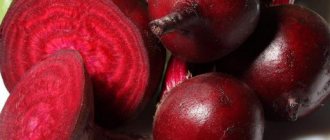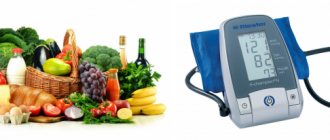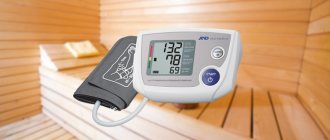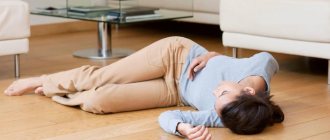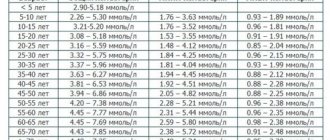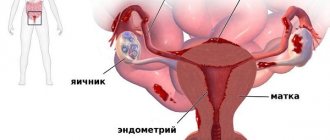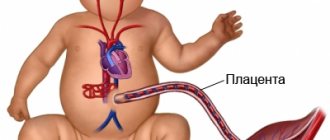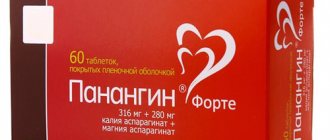Can food affect blood pressure?
In healthy people, there is a natural change in systolic and diastolic pressure parameters. Eating unauthorized food leads to an imbalance in the values characterizing the flow of blood through the vessels.
An imbalance between upper and lower blood pressure leads to overload of the body and worsening of the condition.
If a patient's blood pressure rises after eating, gastrocardiac syndrome is sometimes the trigger. Certain signs indicate the occurrence of a pathological condition:
- increased heart rate;
- pain in the heart area;
- dizziness;
- nausea and vomiting syndrome;
- belching.
Gastrocardiac syndrome is an insidious phenomenon. It is disguised as a malfunction of the heart muscle.
For this reason, it is difficult for a doctor to identify the real disease when a person’s blood pressure rises after eating.
Foods that increase blood pressure
Food that is prohibited leads to increased blood pressure.
You should avoid consuming:
- Spicy. It is harmful to enrich your diet with seasonings: black and red pepper, horseradish, chili and other spices.
- Salty. Excessive amounts of salt inhibit water circulation, increase blood volume, and increase heart rate.
- Caffeine. The tonic substance is found in cocoa, tea and coffee (read about coffee and blood pressure in a separate article). It is better to avoid such drinks, they cause tachycardia. Instead, you can drink fruit drinks, compotes, clean water, and herbal teas.
- Raw beets. The consumption of fresh vegetables is limited to a minimum, since it contains a high starch content (as in all sweet vegetables).
- Fatty dairy products. Food is difficult to digest and causes blood thickening.
- Fried and smoked. Products increase the concentration of cholesterol and worsen the condition of blood vessels.
- Sweets and baked goods. Excessive amounts of carbohydrates have harmful effects. Under their influence the blood thickens. Flour products and sweets are allowed to be eaten in minute quantities.
- Alcohol. Alcohol-containing products instantly dilate blood vessels, and then sharply narrow their lumen, increasing blood viscosity.
Pressure surges are caused by fish of varying degrees of salting, smoked lard, pickled cucumbers, tomatoes and mushrooms, sauerkraut and other preserves.
How to properly create a diet for PG
Is it possible to somehow prevent the manifestation of a painful condition by changing the diet? A radical change in food preferences is included in the complex therapy of hypertension, but there are other important points that patients with this type of hypertension should be aware of.
Prohibited Products
The category of undesirable foods for pathology includes all foods containing a high amount of carbohydrates:
- Sugar and its substitutes.
- Pasta.
- Bakery.
- Fried potatoes.
- Synthetic food additives.
- All types of hydrogenated fats.
Insulin and other substances released when eating foods rich in carbohydrates cause dilation of the walls of blood vessels, thereby contributing to a drop in blood pressure.
Recommended Foods
If blood pressure tends to drop after eating, the patient’s menu should contain products containing the following components:
| Useful material | Treatment options |
| Salt | Table salt to some extent prevents a decrease in blood pressure and can even cause it to jump, since it has the ability to retain fluid in the body. Therefore, pickles, marinades and other salty foods should be consumed in moderation, so that the daily dose of salt does not exceed 15-20 g. |
| Amino acids | These elements are present in increased quantities in nuts. However, they should be eaten raw, not fried. |
| Spices and seasonings | They increase the secretion of the digestive glands and contribute to the narrowing of the vascular lumen. |
| Fats | Fatty foods increase the concentration of cholesterol in the blood fluid, thereby promoting an increase in blood levels. |
| Vitamins C and B | Products with these vitamins should be regularly present on the table: yeast, celery, eggs, sour apples, liver, cabbage and berries, salad. |
| Strong tea, energy drinks and coffee | For postprandial illness, coffee is suitable for hypotension. You should drink a cup of tonic drink after eating. Caffeine helps increase blood pressure, but you should not overuse coffee - excessive consumption can cause a sharp rise in blood pressure. |
When planning your diet, you should not over-eat the foods suggested above. Everything is good in moderation, since excessive consumption of this food can cause the development of other serious illnesses.
Foods that do not increase blood pressure after eating
People with unstable blood pressure need to analyze their daily diet.
Help stabilize the condition:
- baked meat;
- natural yogurt;
- turmeric;
- ginger;
- green tea;
- almond;
- bananas;
- cranberries, currants, viburnum;
- garlic;
- real dark chocolate.
Characteristic symptoms
If blood pressure often tends to change sharply, you should stick to a diet. The manifestation of signs of increasing blood pressure after eating is due to the characteristics of the patient’s body.
Typically, patients complain of the following symptoms:
- headache;
- dizziness;
- seizures or mild nausea;
- heat in the face;
- profuse sweating;
- soreness in the temples or back of the head;
- noise in ears;
- shortness of breath;
- pain, darkness and spots in the eyes;
- numbness of the limbs;
- fatigue.
Patients describe similar symptoms, the intensity of which differs significantly. Patients with normal blood pressure levels practically do not notice these surges.
They are worried about drowsiness, laziness, and fatigue. Hypertensive patients with exorbitant blood pressure “paint” a vivid clinical picture with severe symptoms.
The doctor must determine the treatment, symptoms and adjust the diet. It is very difficult to understand the factors leading to hypertension on your own, to create an adequate diet, and even more so to choose the right medications to stabilize the condition.
Why is it rising?
A slight increase in blood pressure immediately after eating and a slightly increased heart rate are considered a normal reaction of the body.
This natural phenomenon is due to 3 main reasons:
- When a bolus of food is digested, most of the blood is transported to the digestive organs. Blood flow to the heart decreases, the muscles are forced to work harder. This leads to an increase in heart rate.
- During the digestion of food, an increased amount of blood plasma is formed, and the concentration of red blood cells decreases.
- The pressure surge occurs due to oxygen starvation. When nutrients are digested, oxygen is burned in large quantities. The heart and brain suffer from a lack of this element.
When asked whether blood pressure increases after eating due to the quality of food, doctors answer in the affirmative. Foods that can cause an increase in blood pressure include:
- expired;
- harmful chemical additives;
- belonging to the category of allergens.
Changes in blood pressure levels are immediately noticed by patients suffering from chronic diseases. Healthy people whose bodies are sensitive to minor disturbances and allergens can also feel a change in pressure.
Some foods do not raise, but lower blood pressure. But the drop in its parameters does not occur instantly, but after 30-60 minutes. By this time, the food bolus is digested and nutrients are absorbed into the blood.
Patients with fluctuating blood pressure should know the list of products that can deviate its values from the norm.
Features of the influence of different types of food on blood pressure indicators
As a result of a significant number of domestic and foreign studies, the influence of food on blood pressure and their clear relationship have already been proven: salty, fried, fatty, sweet, too spicy foods can increase blood pressure.
Therefore, hypertensive patients should limit the consumption of such food, and in case of exacerbation of the disease, completely exclude it from the diet.
Excess salt and sugar
Salty foods lead to the accumulation of a chemical element such as sodium in the body. Its excess causes fluid accumulation and edema. After eating excessively salty food, a person wants to drink a lot and often. A large amount of fluid puts pressure on the blood vessels, which causes the pressure to jump.
A love of sweets and hypertension are also incompatible things. Digestion of sugar requires large amounts of oxygen and puts increased stress on the organs of the gastrointestinal tract. Accordingly, more blood should flow to these organs.
In addition, sweet foods lead to the accumulation of cholesterol and glucose in the blood. This can also cause increased blood pressure and the development of diabetes.
Junk food
Fatty, fried, smoked foods have a bad effect on the condition of blood vessels, as they lead to an increase in cholesterol levels in the blood. Over time, cholesterol plaques are deposited on the vascular walls, and the lumen of the vessels narrows. This can cause the development of not only hypertension, but also atherosclerosis.
Such food puts a lot of stress on the stomach and intestines, and provokes the outflow of a large amount of blood to the gastrointestinal tract during digestion.
Frequent consumption of highly spicy foods causes an increased feeling of thirst, which leads to the accumulation of excess fluid in the body. In addition, such food increases the number of heart contractions and increases pulsation.
Fasting and overeating
Fasting for more than six hours leads to a sharp drop in blood glucose levels, which leads to vasoconstriction and increased blood pressure.
You should not eat too much late in the evening, right before bed - this puts a lot of stress on your organs. Instead of resting and directing efforts to restore organs after daily life, the body is forced to expend its remaining energy to digest food.
What foods actively affect the body?
Blood pressure almost always increases after eating, but the intensity of this process largely depends on the type of foods and drinks consumed. The foods that most actively increase blood pressure include the following:
- flour baked goods, fresh bread (especially wheat);
- sweet confectionery, chocolate, buttercream;
- smoked meats, pickles, marinades;
- products containing large amounts of animal and vegetable fats;
- sausage;
- some fruits (avocado, pears, lemon, pomegranate, grapes, apricots, peaches)
- some dried fruits (dates, dried apricots, raisins);
- berries: strawberries, currants, wild strawberries;
- among vegetables: carrots, Jerusalem artichoke, leeks, cauliflower, tomatoes;
- among cereals: buckwheat, oatmeal, egg, semolina;
- legumes;
- cottage cheese, butter, cheeses;
- fresh chicken eggs;
- products containing a lot of caffeine (strong tea, coffee, cocoa);
- potato;
- liver, kidneys, brains;
- spices (mustard, horseradish, red, black pepper);
- alcohol, energy drinks;
- sweet carbonated drinks;
- raspberry tea, dogwood compote;
- salted and smoked fish, caviar;
- nuts, especially walnuts, hazelnuts, almonds (they contain a lot of fat);
- some herbs (schisandra, ginseng, leuzea, licorice root, motherwort, rosemary, anise, ephedra);
- dried porcini mushrooms.
If we look at why exactly this type of food contributes to an increase in blood pressure, we can identify several main areas of the impact of such foods on the body:
| Action | Product Example |
| Increased blood cholesterol levels | Potatoes, starch |
| Increased tone of smooth muscles and blood vessels | Bananas, dogwoods, peaches, apricots |
| Saturating the body with excess sugar and carbohydrates | Flour, sweets, carbonated drinks |
| High in fat and saturated amino acids | Nuts, smoked meats |
During hypertensive crises, the listed foods should not be consumed at all, and during periods of remission, their quantity should be significantly limited.
Alcohol has a negative effect on the condition of the heart, brain and blood vessels. Even in healthy people, daily alcohol consumption can cause the development of hypertension and cardiovascular diseases, and in advanced cases, lead to stroke. It should be noted that cognac and dry white wine help lower blood pressure, however, despite this, they should not be taken as a treatment for hypertension.
What will be useful?
Hypertensive patients should pay attention to the following products that help lower blood pressure:
- green tea;
- almond;
- ginger root;
- berries of viburnum, currant, chokeberry, cranberry;
- turmeric;
- garlic;
- spinach;
- bananas;
- dark chocolate (small quantity).
Rules for eating
In order for blood pressure to stop falling or rising after eating, you must follow certain rules:
- if blood pressure increases or decreases, stop fasting and strict diets;
- pressure (low or high) gives the right to introduce foods rich in useful minerals and vitamins into the menu;
- eat steamed and oven-baked food;
- if your blood pressure rises after eating, have dinner 60 minutes before going to bed;
- remove from the diet dishes and foods that worsen well-being (they are different for each person);
- monitor the body's response after eating.
Doctors recommend that patients keep a food diary. The records help determine which foods negatively affect the body and adjust the diet.
Recommended Diet
First of all, you need to include complex carbohydrates in your diet, such as:
- Brown rice;
- seaweed in any form;
- grains (buckwheat, whole wheat, quinoa);
- spices – dried hot pepper and cinnamon;
- products made from natural cow and goat milk;
- sea fish - in particular salmon, rich in fatty acids;
- fruits: ripe bananas, apples, berries - everything except canned ones;
- vegetables in any form - broccoli, carrots, leafy greens, spinach, sweet potatoes;
- chicken and chicken eggs - as a source of low-calorie and easily digestible animal protein.
Advice! Healthy nutrition experts recommend enriching your diet with foods rich in probiotic bacteria: yogurt, kefir, sauerkraut. Probiotics help restore homeostasis in the intestines, which indirectly normalizes blood pressure.
The following activities will also help improve your well-being:
- Clear sleep and wakefulness patterns.
- Try to maintain your work schedule and not reach the point of physical or mental exhaustion.
- Active sports – if you have health restrictions, you can get by with light morning exercises or yoga.
Postprandial hypotension
In some patients, blood pressure does not rise after eating, but falls. Postprandial hypotension develops even in patients with hypertension.
Scientists have not yet been able to find out exactly why blood pressure may decrease rather than rise after eating.
But doctors name factors that can provoke the development of hypotension:
- dysfunction of internal organs in older people (after 65 years);
- endocrine system disorder;
- organic brain damage;
- psychoemotional disorders.
Only a qualified specialist can understand the problems of lowering blood pressure and adjust the diet. When after eating the pressure drops not once, not two or three times, but constantly, spices and tonic drinks are added to the menu.
Doctors make sure that the patient does not overeat and moves more. If the patient begins to eat properly and leads an active lifestyle, pressure fluctuations disappear.
Clinical manifestations
Why does blood pressure drop after breakfast or any other meal? Postprandial hypotension in English means “lunchtime”. This means that blood pressure levels tend to drop after consuming foods. In patients suffering from this disease, the decrease in pressure is, on average, 20 mmHg.
The clinical manifestations of the disease are easily confused with the symptoms of ordinary hypotension. Patients experience:
- heart rhythm disturbances;
- feeling tired and drowsy;
- excessive sweating;
- dizziness and headaches;
- speech and vision disorders;
- pain in the sternum and heart;
- apathetic state characterized by lethargy;
- fainting after a meal.
Patients begin to feel unwell immediately after consuming foods or drinks. Added to the above problems are nausea, leading to vomiting, as well as black dots flashing before the eyes.
Symptoms of postprandial hypotension can occur even in patients suffering from arterial hypertension.
Hungover
Alcohol quickly penetrates the bloodstream. Under the influence of ethanol, blood vessels dilate, the walls weaken, and blood moves through them freely. After drinking alcoholic beverages, hormones are released that increase the heart rate.
When tachycardia occurs, blood is instantly pumped through the ventricles and released into the brain and all internal organs without much effort.
Since the vascular walls do not contract powerfully enough, blood does not enter the peripheral vessels of the legs and arms. The heart muscle and bloodstream are severely worn out.
After ethanol breaks down into metabolites in the liver, factors that negatively affect health appear:
- the blood thickens;
- blood vessels spasm;
- the brain experiences oxygen starvation due to the slow transport of blood to the tissues.
Against the background of alcohol intoxication, characteristic symptoms develop:
- after a binge, the lower and upper pressure rises sharply;
- tachycardia develops;
- headaches occur;
- tremor of the arms and legs is observed;
- muscle pain appears;
- there is a lack of coordination of movements;
- irritation increases.
Dangerous consequences
Alcohol abuse can become a serious threat to health and life. Drunkenness leads to dangerous consequences:
- a condition where blood pressure is always elevated after eating (with subsequent development of hypertension);
- hypertensive crises;
- heart attacks;
- cerebral hemorrhages;
- the occurrence of a stroke or heart attack (if after drinking alcohol the pressure rises to the limit).
If there are signs of intoxication, a person begins to look for ways to reduce blood pressure after binge drinking. Medications belonging to the following categories help to cope with the problem:
- nootropics (such drugs restore blood flow and nutrition of brain tissue);
- antispasmodics (medicines relax tense vascular walls, expand the lumen in the bloodstream);
- adsorbents (products neutralize alcohol poisons);
- diuretics (tablets remove excess fluid and toxins);
- drugs that can saturate tissues with oxygen (after taking the medicine, blood circulation is restored);
- blood thinners (they restore blood supply to tissues);
- drugs to relieve nervous tension and anxiety.
Self-medication for hangover syndrome is prohibited. Only a narcologist can choose the right drug.
To prevent dehydration during a hangover, you should adjust your drinking regime. Water helps damaged organs and tissues recover quickly.
The volume of fluid consumed is affected by the amount of alcohol consumed and the patient’s condition. It is usually recommended to drink about 2 liters of clean water. This volume is enough to restore the water-salt balance in the body and relieve intoxication.
Nutritionist advice
Forming correct eating and lifestyle habits is in fashion today. We see fewer and fewer people gorging themselves on fast food, and more and more morning runners cross our path in the park. A healthy lifestyle and PT are the key to longevity in a healthy person, and for people suffering from hypertension, it is, first of all, an improvement in well-being and the prevention of the development of hypertensive crises.
Important: older people and expectant mothers should follow these instructions especially carefully. Their blood resistance is most prone to instability.
Nutrition rules:
- It is necessary to eat in small portions so as not to put a lot of stress on the body. Hyperphagia entails an increase in blood pressure, so overeating is prohibited.
- The break between meals should not exceed 4 hours. The optimal pause time between main meals and snacks is 2.5 - 3 hours.
- To correct the water-salt balance, a person needs to drink no more than 1.5 - 2 liters of liquid per day. Mostly, it should be clean water without gas.
- Try not to eat food too hot, or, conversely, very cold. Such food can provoke microstress for the gastrointestinal tract. It is better to give preference to warm dishes.
- The last meal should be at least 2 hours before bedtime. It's better not to overeat at night. You can limit yourself to a glass of kefir with bran or milk porridge.
- Limiting the consumption of sugar, salt, trans fats and fast carbohydrates is all a direct path to obesity.
- Hypertensive patients whose blood pressure rises after eating are prohibited from fasting or fasting days. Even therapeutic fasting in this case can be dangerous.
- Immediately after eating, no matter how much you want to, you should not take a horizontal position. It is recommended to walk, stand or sit for at least 10 minutes.
- It is better to give preference to low-calorie foods and spend more time on the move.
- The most preferred cooking methods are: boiling, steaming, baking, microwaves and frying in a non-stick frying pan with a small amount of vegetable oil.
During the period of drug therapy, it is extremely important to maintain a clear daily routine, which includes timely intake of medications, eating at strictly designated times and sleeping patterns.
Important: taking medications 15–20 minutes before or after the next meal increases their potency. In the presence of gastrointestinal pathologies, it is better to take medications with meals.
If, in addition to the means of modern medicine, the patient uses traditional methods of treatment (infusions, herbs, herbal medicine, etc.), it is important to maintain a time interval of a couple of hours between them. During this time, the body has time to process certain substances and, thus, the treatments will not neutralize each other’s effects, but will begin to work with full efficiency.
Do not forget about the compatibility of treatment methods. Before including any folk remedies in your general course of therapy, be sure to consult your doctor.
Remember about the individual characteristics of the body. If atypical changes in condition are observed after consuming a certain product, it is better to temporarily exclude the product and consult a doctor.
It will not be superfluous to keep a diary, where the patient can record the intake of therapy, daily routine, record the time of meals, foods consumed and their body reactions. In this way, the doctor will receive more information about a specific case and will be able to individually adjust treatment for certain characteristics of the body.
Other
Toxins also affect blood pressure. Metabolic products resulting from the digestion of heavy food are retained in the body.
Metabolic disorders lead to intoxication and increased blood pressure. Blood pressure values rise when the blood is thick. Blood viscosity is affected by the consumption of butter, fatty cheese, and cottage cheese.
The nervous and endocrine systems are interconnected: a disorder in one leads to dysfunction in the other. Nervous and endocrine disorders cause fluctuations in blood pressure.
High blood pressure is caused by Parkinson's and Alzheimer's disease, psychopathic seizures and other neurotic conditions.
Blood pressure jumps after eating in people on hemodialysis. This procedure is performed on patients with acute renal failure.
What to do
People with blood pressure that increases after eating need to constantly monitor their health, change their established lifestyle, and develop healthy habits.
Blood pressure levels are normalized when certain requirements are met. Patients should:
- establish a drinking regime (drink a maximum of 1.5 liters of liquid per day);
- use low-cholesterol products in the menu;
- eat foods rich in Omega-3-6-9 acids and potassium;
- control body weight.
If the pressure cannot be brought back to normal, you cannot do without a hospital; You need to tell your doctor what exactly is bothering you. The doctor will order an examination, find the root cause of unstable blood pressure, and draw up a treatment regimen.
For hypotension
To combat hypotension, synthetic and herbal medicines are prescribed. The drugs stimulate the functioning of the nervous system, heart and blood vessels.
Herbal medicines have a gentle effect on the body. Signs of hypotension are relieved with alcohol tinctures:
- Eleutherococcus;
- Chinese lemongrass;
- ginseng.
Synthetic stimulants help normalize low blood pressure:
- alpha adrenergic agonists;
- analeptics;
- anticholinergics.
Medicines with a tonic effect are taken strictly as prescribed by the doctor. When choosing medications, the doctor takes into account the symptoms of hypotension.
For hypertension
When prescribing medications to stabilize blood pressure, the doctor takes into account the stage of the disease, concomitant pathologies, and the patient’s condition.
Hypertensive patients should understand that treatment must be carried out under strict medical supervision. When taking medications on their own, patients run the risk of life-threatening complications.
The pressure is normalized under the influence of:
- diuretics;
- b-selective adrenergic blockers;
- angiotensin-converting enzyme blockers.
Antihypertensive pills (after binge drinking)
Doctors are cautious in prescribing antihypertensive pills to relieve hangovers. Some medications cannot be combined with ethanol. When substances interact, unwanted side effects occur. Potassium, magnesium and other minerals are washed out of organs and tissues.
To relieve pressure that occurs after binge drinking, use:
- diuretics;
- preparations based on reserpine and dihydralazine;
- imidazoline derivatives.
Treatment with folk remedies
To lower blood pressure, traditional methods are used:
- Flax-seed.
It is used when blood pressure rises in the body due to high cholesterol. The product contains omega-3 acids. The seeds are ground in a coffee grinder. Take 3 tbsp. powder daily. The product is added to dishes or eaten in its pure form.
- Juices from carrots, beets and cucumbers.
Drinks cleanse the walls of blood vessels from cholesterol and calcium deposits and reduce blood viscosity. Mix freshly squeezed carrot, beet, cucumber juices and fresh kiwi juice in a ratio of 10:3:3:1. The cocktail is taken on an empty stomach, 50-100 ml 3-4 times a day.
- Fruit drinks and teas with viburnum.
The berry has a gentle diuretic effect. After excess fluid leaves the body, the pressure decreases.
People whose blood pressure drops after eating enter a state of sleep. In such cases it is recommended to use:
- licorice;
- hibiscus;
- hawthorn.
Plants are used to prepare herbal teas. Brew 1 tsp in 250 ml of boiling water. any raw materials (from the above). Drink 100-200 ml 3-5 times a day.
Products that actively affect the body
A varied diet... What does this mean? We are talking not only about the balance of proteins, carbohydrates, fats, the ratio of meat and vegetables, but also about the color of food. What colors should be present in the diet and why?
White
White foods reduce blood pressure, cholesterol, and prevent the flu.
Products:
- fish;
- chicken breast;
- garlic;
- rice;
- cauliflower;
- cottage cheese;
- kohlrabi;
- leek;
- milk.
Yellow
The group of yellow products is an effective antidepressant, strengthens the nervous system, detoxifies the body, cleanses the digestive tract, and awakens the activity of the lymphatic system.
Products:
- bananas;
- corn;
- lemon;
- yellow pepper;
- a pineapple;
- peaches;
- nectarines;
- egg yolks;
- papaya.
Orange
Orange foods contain vitamin A, which is important for many body functions.
Products:
- carrot;
- pumpkin;
- apricots;
- mango;
- oranges;
- tangerines;
- sweet potato.
Red
Red foods dilate blood vessels and improve blood flow.
Products:
- red pepper;
- tomatoes;
- red cabbage;
- berries;
- cherries;
- raspberries;
- watermelon;
- pomegranate;
- red lentils;
- Red beans;
- strawberry.
Blue
The best protection for the body is blue food, one of the most powerful antioxidants.
Products:
- eggplant;
- dark grapes;
- plums;
- blueberry;
- blackberry.
Green
Green food is a source of vitamins C and K. Among the most valuable substances is chlorophyll.
Products:
- broccoli;
- spinach;
- leek;
- chard;
- herbs;
- avocado;
- cabbage;
- salad.
Prevention
Persistently rising blood pressure after eating is a reason to change your lifestyle. The functioning of the body improves with a properly structured regime:
- going to bed - no later than 23.00;
- morning awakening - at 6.00 am (duration of sleep - 7-9 hours);
- intense physical and mental work - until 17.00;
- reduce physical activity in the evening;
- create a diet (a nutritionist will help you choose dishes containing antihypertensive foods);
- improve the psycho-emotional background (situations leading to nervous tension and stress should be excluded).
Reasons for changes in pressure
There are various reasons that lead to an increase or decrease in blood pressure. After smoking, blood pressure increases by 10 mm. rt. Art. Heavy physical and sports activities, regular stressful situations, and poor lifestyle lead to sharp jumps.
Important! Many patients are diagnosed with primary or essential hypertension, the causes of which have not yet been studied.
Risk factors lead to the rapid development of pathology. Hypertension in most cases occurs due to a genetic predisposition. The following reasons can be identified:
- Excess weight. With obesity in the body, the load on the work of the heart and the walls of blood vessels increases;
- Large amounts of salt in food. Many people do not pay attention to the deficiency of calcium and magnesium in the body. As a result of such a pathological disorder, the condition of the vascular walls worsens;
- Abuse of bad habits. Smoking increases the likelihood of blood clots several times over. After smoking a cigarette, the walls of blood vessels narrow greatly;
- Sedentary lifestyle. In the body, blood circulation through the veins decreases, vascular tone decreases;
- Nervous tension, regular stress. These negative factors lead to a sharp increase in blood pressure. When a person calms down, the condition returns to normal. With frequent and prolonged stress, hypertension develops;
- Short-term increase in blood pressure. Many people react strongly to medical workers who wear white coats. As a result, their blood pressure rises sharply, which returns to normal on its own.
Overexertion and stress cause increased blood pressure.
Secondary hypertension manifests itself as a result of the progression of other diseases in the body. The most common reasons:
- improper kidney function;
- liver pathologies;
- failure in the endocrine system;
- disruption of brain function;
- diabetes.
Only by eliminating the cause of high blood pressure can the indicator be normalized for a long time. To do this, you need to seek help from a doctor and undergo a comprehensive examination.
Tips for normalizing your diet
A balanced diet allows you to stabilize your body’s functioning:
- you need to eat fractionally (about 5-6 times a day in portions of 250 g);
- clearly define the time of meals: eat strictly at the same hours;
- give up drinks that are guaranteed to increase vascular tone;
- use salt substitutes (garlic, kelp, celery, lemon, oregano, basil, parsley) instead of salt;
- avoid eating fatty foods (when a person eats a lot of fat, the blood thickens and problems with digesting food appear);
- In your diet, you should give preference to products that improve digestion and normalize blood pressure (fresh vegetables, fruits, herbs - they contain fiber, minerals, vitamins).
In people with chronic pathologies, when eating, you can observe not only high blood pressure, but also other unpleasant symptoms associated with digestion. To prevent complications, you need to create a menu together with your doctor.
Therapeutic methods for eliminating postprandial hypotension
Postprandial hypotension is treated with complex therapy, and the treatment regimen is selected taking into account the characteristics of the underlying cause of the pathological condition.
Cardiology practices the following therapeutic methods:
- Review of diet.
- Lifestyle changes.
- Drug therapy.
- Folk remedies.
Diet
First of all, with PG, a person’s diet needs correction.
If arterial levels tend to decrease after eating food, you should listen to the following medical recommendations:
- You cannot eat hot food.
- Avoid foods rich in carbohydrates.
- The menu should include tea, cocoa and coffee in moderation.
- When preparing dishes, add various spices and fats.
- Portions should be small.
- Preference is given to greens, lean fish and meats, legumes, dairy products, cereals, fruits, vegetables and nuts.
- You need to eat often, at least 5-6 times a day.
- After finishing breakfast or lunch, you should not rush to get up from the table, but sit quietly for 30-40 minutes.
- Drink enough water throughout the day (at least 2 liters).
- It is strictly forbidden to overeat and drink a lot of sweet drinks.
Treatment with medications
Therapy for postprandial hypotonic pathology consists of taking medications prescribed by a doctor. Usually prescribed:
- Octreotide.
- Levodopa.
- Midodrine.
- Ibuprofen.
If you have diabetes mellitus, drugs that inhibit bowel emptying, such as Acarbose, are prescribed.
To increase the therapeutic effect of medications in the form of additional treatment, the following are recommended:
| Caffeine tablets | Adaptogens | Physiotherapy |
| Pentalgin-N, Citramon, Algon and others. | Tincture of eleutherococcus, lemongrass, ginseng. | Hydrotherapy, mud therapy, massage, electrotherapy and sauna therapy. |
The above remedies should only be used with medical permission. Self-medication is not allowed, since in most situations hypotension is a secondary pathology that occurs against the background of a primary disease.
Changing lifestyle
Regardless of the type of hypotension manifested, the patient should lead a healthy lifestyle. Changing life habits during PG means:
- Quitting smoking and alcoholic beverages.
- Engaging in physical activity.
- Systematic walks in the fresh air.
- Performing physical fitness exercises, swimming.
- Correction of wakefulness and night rest (sleep at least 9-12 hours).
- If a drop in blood pressure is observed with regular frequency, compressor stockings should be worn. Special underwear increases blood flow to the myocardium.
- In the morning after waking up, you should not get out of bed abruptly; you need to get up slowly, making sure to sit on the edge of the bed.
Alternative medicine recipes
The folk hospital offers many effective recipes for eliminating postprandial hypotension, but home remedies should be used as an addition to the main therapeutic methods and only with the approval of the attending physician.
The following herbal remedies provide effective results:
- Ginger root.
- Rhodiola (pink) extract.
- Pomegranate or pomegranate juice (freshly prepared).
- A drink made from a coffee mixture (ground coffee, lemon juice and honey).
- Herbal decoction (valerian, buckwheat, licorice, string and panzeria).
- An infusion of rosehip and hawthorn berries, rhodiola, St. John's wort and nettle.
conclusions
Normal blood pressure is considered to be 120/80. Values above this indicate the appearance of hypertension. The pulse quickens, there are signs of tachycardia.
To ensure that vascular spasms do not occur after eating, blood viscosity remains normal, and blood pressure does not increase, you should monitor your diet. Use products that can cleanse and strengthen blood vessels, reduce cholesterol, thin the blood, and restore tissue trophism.
If the levels are persistently high, seek medical help. The doctor, having found out the reasons why blood pressure regularly rises after eating, prescribes appropriate medications and folk remedies for the treatment of hypertension.
Prerequisites for the disease
It is impossible to unequivocally answer the question of why blood pressure drops after eating.
There are some factors that contribute to changes in pressure:
- elderly age. Patients over 65 years of age are susceptible to the disease due to age-related changes occurring in the body;
- organic brain lesions, including Alzheimer's disease and Parkinson's disease;
- mental illnesses, including neurasthenia, psychopathy, neuroses;
- endocrine diseases.
Patients who regularly attend hemodialysis and patients with chronic kidney disease are at risk of developing this disease.

